#this scene is a screencap goldmine
Text
The "Uzi is Cyn/the unknown mansion drone" Theory Masterpost because I have been driven insane by stuff I've noticed.
Choosing to believe I was right in my post-episode 2 theories in that the unknown drone in the mansion and Uzi were connected, but specifically because of these screencaps.
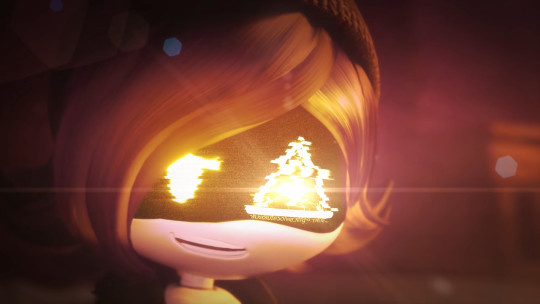
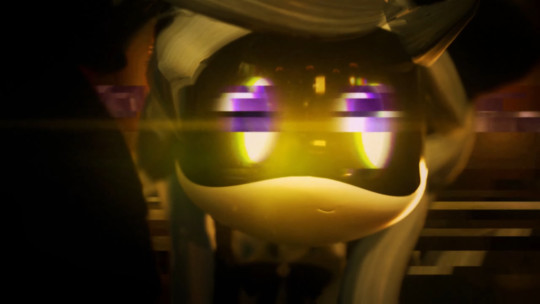
N, J, and V had white eyes in the flashback (if you level adjust the colors), unknown drone girl clearly has yellow eyes. Uzi's color briefly turns yellow in the pilot when Absolute Solver becomes enabled on her. Unknown girl's introduction glitches her eyes a few times in a purple tint.
So now I'm returning to this observation after episode 4 where this goldmine was dropped:
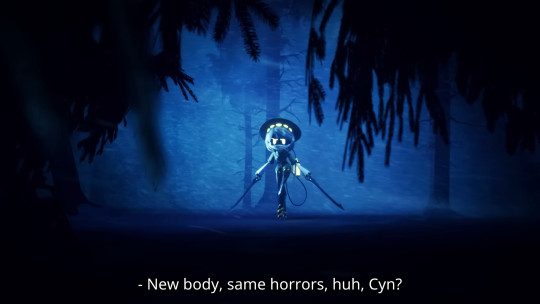

This goldmine, whatever it means.
This goes in one of two ways. One, Cyn is a disembodied AI/horror that can possess drones with Absolute Solver enabled. Cyn possessed the body of the drone from the mansion before. Or...
Or: It's MUCH more fun to consider that Cyn is the drone from the mansion... and is Uzi's previous identity. Or at least is part of Uzi's psyche somehow. Before I get into this idea, let me talk about N's reboot message from the pilot. It's "STRING "ABSOLUTE SOLVER" BLOCKED BY ADMINISTRATION "CYN"" and I wanna point out that it doesn't actually refer to Cyn as an administrator. It's "Administration" and Cyn is placed into quotes, perhaps as a codeword? We know now from episode 4 the mansion drone did something terrible using Absolute Solver, so her name may have become the name of a failsafe placed on N, J, and V.
So, where is evidence for Uzi and Cyn being the same drone? I wanna point out something from the season 1 teaser:

Wow, that looks a lot like the mansion from N's flashbacks!
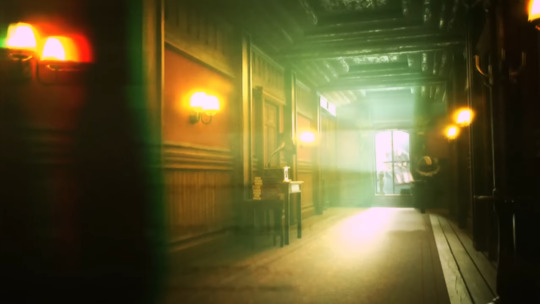
Same record player, wall lights, maybe same window even? It's very similar. So why's Uzi in this place she's supposedly never been in? Perhaps "Uzi" never lived there, but her life as Cyn did. If this theory is right, then the killed drones on the floor below her may represent J and V, whom she saw as competition to N's attention.
And also consider this:

Uzi sees this figure while investigating the campgrounds. This figure looks a lot like Tessa. That, or it's Cyn (with black hair for some reason?). They both wear bows so that's no help lol. It'd be very strange for her to see either of these characters in this sort of hallocination way because she should have never seen either of them before. Perhaps it's old memories resurfacing? There's also a hand she sees peeking from the side, which is exactly what Cyn does when she first introduces herself to N, V, and J.
On a weird note, it'd been pointed out to me that if you brush Cyn's hair down and cut her longer locks shorter, it would pretty closely resemble Uzi's hair style. I only find that interesting because Cyn's bangs are so weird there's gotta be some reason for them looking that way. Idk take a look.


Also while I'm at it, potential other clue to this theory or something AS-specific. When Uzi turns the arrow to flesh, her AS ability turns yellow. It turns red when it actually overheats later in the cabin (one wonders how this works on Doll). Every time we've seen AS and flesh it's yellow? Note Cyn showing off the tasty human hand in her mouth while her naturally yellow AS is activated. Uzi turns yellow when she decides to kill humans and later again when she turns the arrow to flesh. It was at the arrow scene where V became convinced that Uzi was Cyn. Yeah, this is all mighty suspcious lol.
Let's get into some weird stuff. Solver Drones have this zombie theme going on and Uzi does Fatal Error during this episode, so she's technically dead. Whether or not she's only dead now or has been for a while is debatable. See my last theory post on if she's even a Worker (anymore?) for additional doubt into our understanding of Uzi because we have never seen her Worker symbol at all for some bizarre reason.
On a related note, Eldritch J telling Uzi that "it hurts our feelings you don't remember us" is curious. It proceeds to show her an image of her and Nori. Nori's the key to whatever this is, this theory or not. Considering the "Uzi is dead" flags, perhaps the original Uzi died and whatever happened at Cabin Fever Labs led to Cyn becoming Uzi, who is only now beginning to remember this other past she had. The old Uzi being "reborn", so to speak, would provide an actual explanation for Khan thinking she had a totally different personality during the talk with the teacher and her classmates forgetting who she is. Might be a reach, but hey that's how it be when you talk about Liam's stuff.
Also wanna point out that Eldritch J's VA has been liking tweets about Cyn/mansion drone, most of which are theories like this where Cyn is the mansion drone. I can see that as only a confirm on her being Cyn's VA, but maybe a point for this theory.
Alternatively, this was all a huge red herring and Cyn is something entirely different. I am merely trying to read into this specific theory and see what connects.
#murder drones#murder drones theories#long post so read more#this theory is such a Design moment#Internecion Cube too since Uzi and Ic-0n share a lot of traits apparently#shoutout to the server that went insane with me over this theory#I need to make the MD sideblog already
73 notes
·
View notes
Text
Todd Haynes on Velvet Goldmine and Fandom (and Gender, and Yaoi, and Slash Fic)
Source: "Something that is Dangerous and Arousing and Transgressive: An Interview with Todd Haynes," Julia Leyda.
Edits and emphases my own :) The whole interview is fascinating, and while I kept most of the Velvet Goldmine stuff in this post, there are more bits to read about it, as well as conversation around Todd Haynes' other films. This is gonna be a really long post, with screencaps throughout, so find it below the cut!

JL: You've done several movies that are very clearly woman's films, but the movie that I am most fascinated with in terms of gender is Velvet Goldmine, which is not usually interpreted in that context.
TH: No, except it's probably gotten the strongest female fan base of any of my films. And what's wonderful for me is to see new generations of young women, even as we think we progress as a society and there are new options available to each new generation that seem to be catering to that market more acutely, still Velvet Goldmine offers that market something that they’re not getting elsewhere. I always love it when girls come up to me at festivals and that’s the one, that’s the movie that really turned them around.
JL: I’m interested in how you use the trope of playing with dolls in Superstar and Velvet Goldmine as a way to figure gender, embodiment, desire, identification. You said in an interview that playing with dolls is what you’re doing in Velvet Goldmine, using it as a metaphor for the filmmaking process, to play with the characters of the idols more than making an actual biopic about bisexual pop stars. So what about the female characters in Velvet Goldmine? Fans, rock and roll girls like Mandy — talk a bit about them.
TH: Interesting question... I don’t know if [the role of the rock-n-roll girl and the role of Angela Bowie in glam] relates directly to doll-playing except that it really might be the last time that you see an active female figure freely utilizing artificial terms of self-expression and persona in an unembarrassed, unabashed, almost radical way. That was in a way the fascinating counterpart to the more aloof, silent, objectified figure that Bowie assumed as Ziggy Stardust. Of course, there was also that hardcore influence from the American music that he loved — the Stooges, the MC5, and the Velvet Underground and Lou Reed — as the final ingredient to give it that kind of duality, the cross between English musical traditions and this American hardcore, a direct assault. He needed both of those, but there was still a kind of passivity and object-ness of that figure that seemed more quiet, and more comfortable being an image, an idealized beautiful façade that people could project onto; whereas Angela Bowie was active, pulling the strings and moving the levers — in that way, I think, making him up so that he was the doll that she was playing with. So a lot of that energy and that fire and fearlessness I think could be attributed to her.
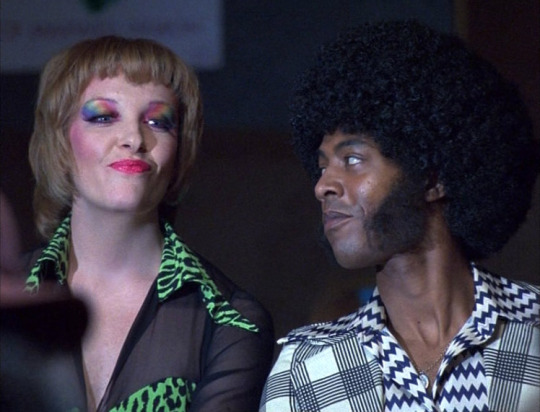
JL: In the doll-playing scene in Velvet Goldmine, the girls are like Mandy, manipulating them and fantasizing about them. So that trope of little girls playing with dolls scene really gets at the way the movie is about bisexuality and a kind of less bordered sexual identity, that is based in play, in fantasy —
TH: — is fluid, is mutable, is conducive to all kinds of voices and all kinds of players pulling the strings. But one thing that Velvet Goldmine kind of misses is how strongly and passionately young women were the driving desiring consumers of this very unique moment in popular culture history. That has continued, too: the androgynous male object is something that still attracts a really passionate, active female spectatorship. That’s so fascinating to me, and you can see it played out in so many different ways: the tradition of the Japanese comics of the ’70s, what’s it called again?
JL: The subgenre of manga with the boy lovers and its girl fans, yaoi.
TH: Exactly. The boy lovers and the girl fans, really directed at girl consumers, and it’s this androgynous, starry-eyed princes and pretty boys who have sparkly eyes for each other.
JL: I wondered if you were aware of yaoi or not. When I was working on a conference paper about the girl fans in Velvet Goldmine some of my colleagues said, Hey that’s just like yaoi! And I said, Wow, it really is, but I have no idea if that’s part of what he was thinking or if it’s just a coincidental, cross-cultural parallel.
TH: It was a tangent that I learned about in the process of research, but I don’t remember when exactly. I was certainly aware of how there was a particular Japanese following with a passionate attachment to the Bowie phenomenon, glam rock, T. Rex; Japan made up a major part of their market. But I think it’s an interesting counter-argument to the classic Laura Mulvey idea of a limited female spectatorship and if anything it only further underscores — although I think this is all embedded in that, and though I haven’t read those articles in some years — that marginalized subjects, such as gay subjects and women, have to find a more dexterous and nuanced way of reading culture and finding their way into all kinds of content that is not designed for them. I think there’s this ability to transform and to enter into all kinds of different subject positions of which this is one amazing and fascinating example: the glam rock thing with young girls’ driving interest in it.
JL: When I was a teenager I was a huge Bowie fan, and my mother was confused because I was always trying to look like Bowie; she would say, “You’re attracted to him, you have a crush on him, why do you want to look like him? When I was younger I loved Jean-Paul Belmondo, but I didn’t want to look like him.” But in the ’70s, and in my case the ’80s, and still today I think, girls of all sexual orientations experience that overlapping between desire and identification — it’s there in the Arthur character, too, but I’m thinking of in the opening sequence with the glam girls rampaging.
TH: Right, they’re absolutely rampaging, terrorizing the town in utter desire. And we all know that the passion that we see displayed there, the intensely sexual display of female spectatorship probably started with Valentino, Sinatra, the Beatles, and Elvis.

JL: It’s almost hysterical.
TH: Yes. There was in these cases an androgynous, feminine element to the actual performance; in a way, just for the star to be up on stage, just to be objectified, is to arguably be feminized. These artists in their unique and shaded ways capitalized on that, and the result among female spectators is something that society is still startled by: that radical emotional response that it engenders... Each generation has its own variant on that. It does call into question all sorts of assumptions about opposites attracting, the whole simplistic reductive ideas of what drives desire —
JL: — and the borders of identity.
TH: Yes, and the female subjects, spectators, consumers, maybe because they’ve had to learn how to occupy different subject positions in dominant patriarchal culture, have revealed the ways that desiring has narcissistic or self-reflexive aspects. On the other hand, maybe male spectatorship has just been so much more catered to and delineated in solid terms, and thus hasn’t been able to explore the margins as thoroughly, but women and gay people and African Americans, for example, all have to find different ways of entering mainstream cultural production.
JL: I love that the girls with the dolls in Velvet Goldmine are storytellers, they are controlling the narrative, in a sense, and that you say that that’s what you were doing as a director.
TH: I think that’s how we all begin to externalize our desires: through storytelling. Dolls are a tool that lends itself to that; they are supposedly made for little girls, and I loved dolls when I was a kid. The Barbie doll became a multiply useful subject in the Karen Carpenter film, and that was the internal nod that I was making in Velvet Goldmine, but it was so relevant it didn’t feel like a detour or a private joke — it felt like it was getting to the core of the intense effect that is felt by these kinds of characters in popular culture. That free-floating desire in the little boy-romance that the little girls are constructing is about as sweet and tender as anything in the film.

JL: That kind of storytelling, the freedom in play, helps the characters, but also the rest of us, decide who we are and how we want to tell our own stories.
TH: It’s the story and the engine of the film. It is really the fan’s point of view — the Arthur character, obviously — but it’s really the theme and the whole motor of it. I always knew I wasn’t really interested in getting inside the closed doors of these famous subjects and that’s why a fictionalization of this unique period made sense. We all already fictionalize and fill in and fantasize. And we see it too in the whole slash fiction phenomenon, which I didn’t even know about until Velvet Goldmine, and in which Velvet Goldmine has itself become a category.
JL: That’s the cool thing about Velvet Goldmine — it is itself a sort of slash fiction, and there’s this ongoing spin-off slash fiction community carrying the stories forward — it’s a perfect loop.
TH: Yes. To ignite that little flame that makes people want to respond actively and creatively and participate. It reminds me of a girl… I was scared of Bowie when I was in junior high school, and I remember I was aware of him, but it was all just too freaky. There was a girl in a lip sync show in seventh grade who picked his song “Changes.” She was this beautiful girl and she imitated him, as many girls did, right, because he was so pretty... [S]he just did the perfect lightning bolt like Aladdin Sane, and she got her hair just right — I forgot if she wore a wig. But she performed “Changes,” and I remember hearing and thinking, “Oh, this isn’t so scary . . .” because I expected it to be really hardcore music and I would be put off by it. But it was so pretty.
JL: So she turned you on to Bowie.
TH: She really helped...
JL: I’m trying not to let my brain explode with that idea! I remember that scene in Velvet Goldmine where they’re reporting on the news, saying something like, “Girls everywhere are wearing glitter makeup,” and that conveyed the society’s sense of fear, of what are all those girls up to? The idea that they’re going to need to be controlled again somehow because they’re getting a little too weird or too powerful.
TH: The glitter girls, as they were sometimes called, especially the LA version of the glitter girls, that’s another thing I really remember from junior high. As I read later when I studied this period, they were a force to be reckoned with — extremely precocious, among some of the youngest, most adventurous and not violent, but persevering, fearless, active fans. They peopled the Rodney Bingenheimer English Club on Sunset Boulevard —
JL: Like the Runaways.
TH: Yes, they gave birth to the Runaways. I think it was one of those girls who ended up in Roman Polanski’s house, who was fifteen or however old she was, but that’s why it’s very hard to examine that infringement outside of its cultural context and what was happening at the time in Los Angeles. Glitter girls scared the shit out of me when I was a kid — they were tough, and girls were already ahead of boys at that age, but they were miles ahead. It was intense. I can absolutely picture those kinds of girls, and they were intense, in their platform shoes and glitter makeup.

JL: With Arthur, I thought you did such a great job developing that character as a kind of giddy, exuberant, awkward young guy. You’ve said that Velvet Goldmine was your most affirmative film, even though the ’80s scenes are so dark, it provides the character of Arthur with this memory to cherish even in the middle of the awful ’80s.
TH: Totally. I don’t know if there’s a more joyful moment in any of my movies than that little passage that I’ve been showing as a clip in a couple of festivals and retrospectives of Arthur getting the record, and making his brother agree to lend him the money taking it home, opening it up, and that cherished —
JL: Fetishized!
TH: — fetishized record. And then he leaves the house, stashing his coat and just prancing proudly with his badges down the street with the song playing, and yet still being met with this higher echelon of socially superior kids who look down on him, and the pretty boy who scowls at him for his presumption to even be in their company. But still I think every kid has some version of that: his awkwardness, his passion, his vulnerability, and his strength, too, are all embodied in that ability to fall in love.

That beautiful sequence ends with him turning the page one more time to the page with the image of Curt and Brian kissing. And I remember feeling that, a kind of recoiling, confusion — like it’s tapping something exact, absolutely precise, but just too many membranes down to be able to be freed up, able to be voiced or affirmed. But it’s something you’re bookmarking for the future, that feeling you’re going to return to when you have a little more strength, a little more perspective. It’s touching something that you know you’re going to have to get back to because it’s something that is dangerous and arousing and transgressive. Christian's performance is so amazing because that sequence starts with him in the classroom, where he really looks all of a sudden like he’s fourteen years old, with his ruddy cheeks —
JL: — and his really bad bangs. I identified with him utterly and painfully in that scene. And his flailing dancing scene. My God, that character is so beautiful.
TH: He did such a beautiful job. He really was so committed and so profoundly inside that guy. I remember when we wrapped and he put away the Arthur clothes and he came back and said, “I just put away the Arthur clothes and cried a little bit.” And I don’t know if I cried but I sure felt like I could’ve. I think despite all the beautiful, fancy guys in that movie, I think my heart belonged to Arthur.
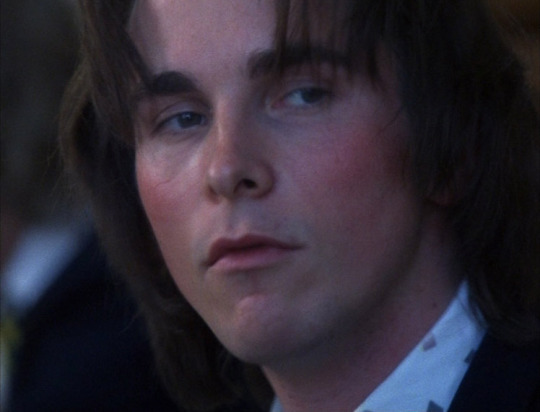
JL: Of course, because Arthur’s us.
TH: He is.
JL: When he takes that coat off and starts walking down the street it’s just: yes! We were all there. I like the way that film gives a few different positions over to that kind of fandom: audience member, fan, young person who’s still working things out, still trying to figure out who they are, and who they want, and who they want to be. The girls as well as Arthur.
TH: It’s also why the whole package of bisexuality, a kind of performative, made-up, dressed-up sense of identity and self, and coupled with this sense of being extraterrestrial, speaks so directly to adolescent instability and to that moment of uncertainty. It couldn’t have been a more total package for the mutability of that time, touching all the nerves and also the freedoms that dressing up allows you, and imagining different kinds of love objects that aren’t necessarily the ones you’re supposed to have. But even that is blurry, unfixed.
JL: Tommy Stone’s star image shows the other side of that dressing-up, right? If you can change yourself that radically, you can also change yourself into a horrible, plastic thing.
TH: Right, and a kind of converse example. The female fan who comes up to Arthur in that final scene at the bar who is so ecstatic about Tommy Stone because that’s all that generation has. That’s what they got — it’s not their fault that the same desire, the same need for something special is expressed, but it’s just not radical, or progressive, or culture-changing. But it’s what they’ve got, and I didn’t want to blame them because they are part of a culture that had to clamp down around categories once again, resume control of those categories that were seeping into each other so surprisingly for a brief time.

JL: Exactly. That limited world that she inhabits and Arthur’s wistful smile as he gives her the press pass, seeing her giddiness.
TH: Just as the emerald pin is the ultimate token of passing on heritages and opportunities or insights or ways of radically inverting a person’s destined experience. That’s how that scene is framed with him passing on the press pass to her and Curt passing on the pin to Arthur. There’s a nice sense of camaraderie among generations and different stations.
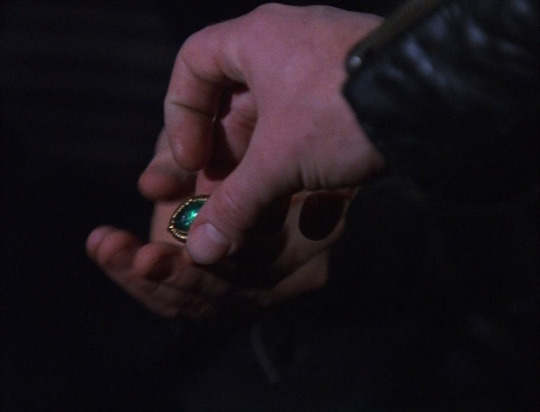
10 notes
·
View notes
Photo






I don’t even know whose face I like the best...
#yowamushi pedal#yp thoughts#sohoku#imaizumi just looks so done and it's so fucking funny#AND JUST LOOK AT NARUKO HAW ADORABLE IS HE?????#this is from the scene where tadokoro's stuffing his face with food lmao#i have some screencaps of imaizumi that i saved on my computer forever ago with no context so i'm trying to figure out WHY i saved them.....#thus i'm jumping around a bit to try to find the scene where they're from...... blah#but by doing so i found this goldmine so i don't really have any complaints lmao
18 notes
·
View notes
Text
MYSTERY’S TAILS GROW WHEN HE LOSES SOMEONE
oKAY SO. I was rewatching the MSA series and I found the Mystery’s tail count in his kitsune form fluctuates. I thought this was obviously intentional and went and found every single canon screencap I could of Mystery in his kitsune form and counted the tails:
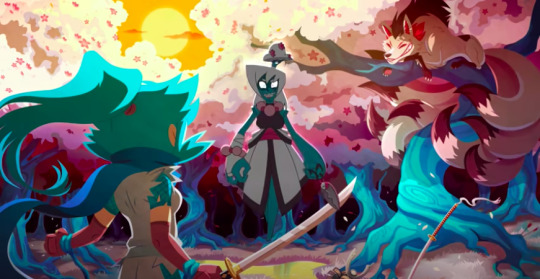


You can see that the earliest we see Mystery canonically he has a count of 9 TAILS. In Ghost, however, he only has 6:

I’m not sure what happened here -- I guess we’ll come to know as the series progresses. But stay with me here: from this point in the Ghost timeline and onwards, I noticed a pattern. We know that officially, after this shot, the gang loses Lewis, or at least realises that he’s gone (not dead, but they think he’s missing in canon).
The next time we see Mystery’s kitsune form is in Freaking Out, and while I could not get a good enough quality shot to count all his tails, this montage with Arthur shows us he now has 7 tails:
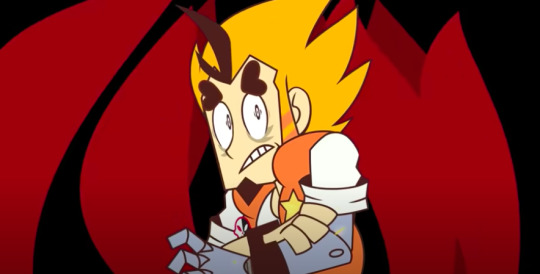
I continued to monitor his tail count in The Future (we do not get to see Mystery’s kitsune form with all his tails in full view in Hellbent) and you see that since Freaking Out, Mystery’s tail count has remained the same; he has not
“lost” anyone in this time period--


However, we see in The Future that his tail count starts to grow. First, Vivi is attacked and injured:
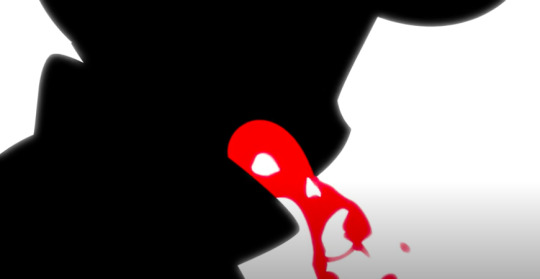
We see a look of shock and fear on Mystery’s face, and then a blue stream bursts out of the heart--
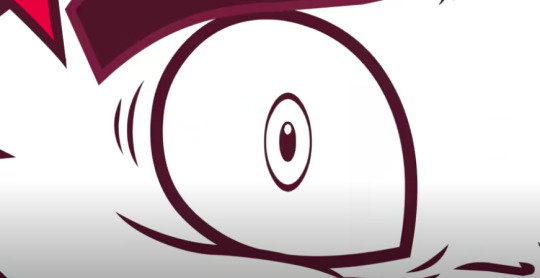
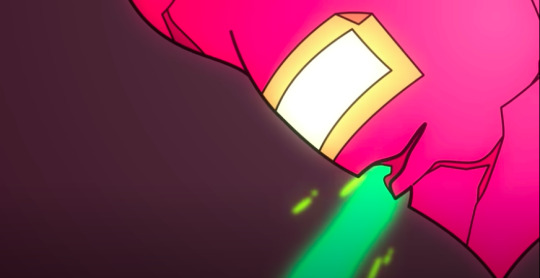

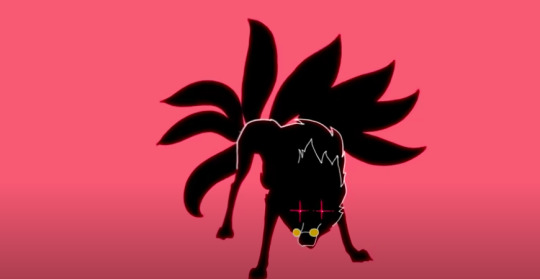
And in this scene we actually SEE Mystery grow a new tail. After having Vivi hurt, he now has 8 TAILS.
The next incident is when Shiromori is dispatched (and she also has a heart that resembles an apple, how cool!):


Again, we see the look of shock and fear, and some might even say pain, before a white stream bursts out of the heart:



--AND HE GROWS ANOTHER TAIL.
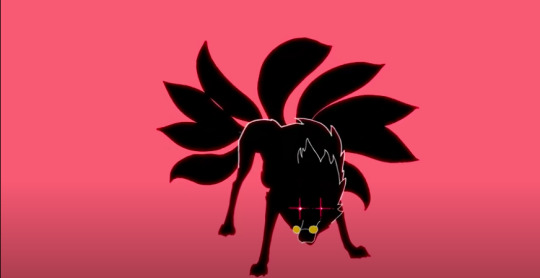
Now with a count of 9 tails, Mystery’s reached the tail count of the earliest form we see him in. So what’s the pattern?
Everytime Mystery “loses” someone or sees someone important to him hurt, he GAINS A TAIL. (With the exception of perhaps Arthur -- but maybe this can be explained by Mystery growing a tail and having the count total 6 as a result of Lewis’ death and then growing to 7 when he amputates Arthur’s arm, or the other way around -- 6 injuring Arthur and 7 realising later that Lewis is “lost”.)
And how do we know this? Well, most obviously, we know Mystery cares about the Mystery Skulls group and this feeling of inclusion is returned by Lewis, as we see when we see Mystery as well in his locket:

But what about Shirmori? Isn’t he afraid of her?



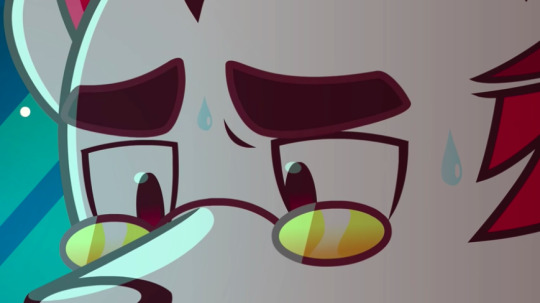
Be that as it may, it still shows a great amount of emotion between Mystery and Shiromori and we see further hints to this complex relationship in The Future:

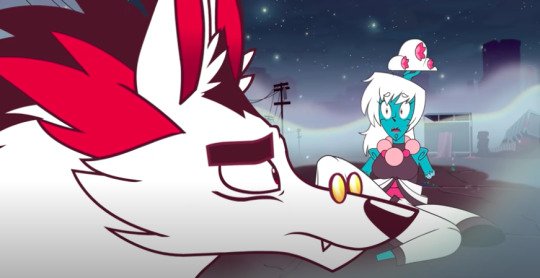


We see Mystery looking worried and regretful, Shiromori appearing surprised at his defence of her and we also see Shiromori with a tear in her eyes after gazing at the injured Mystery. This implies a deeper relationship between them than we previously thought and explains why Mystery was so distraught upon her demise that his “heart” burst and he grew yet another tail.
So what do we know? In traditional Japanese folklore, a kitsune’s tail count is usually either related to how old they are (100 years per tail) or how wise they are. In Mystery’s case, we see that since Ghost he grows a new tail everytime he loses someone important to him, and this may line up with the “more tails = wise” kitsune hypothesis.
But, aside from growing a tail each traumatic event, we see that each time his “heart” ruptures as well, which can’t be good. We see this firsthand with Vivi and Shiromori and we can possibly predict that one or more of the orange/yellow/purple streams are related to Arthur and Lewis.
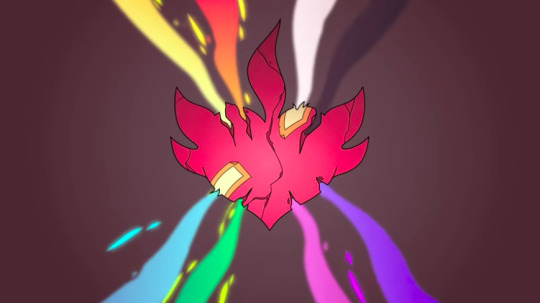
But what of the green and the black? I suppose we’ll just have to wait and see about that. But what we can see is that there are eight “rupture streams” which I believe may represent “lost” or “injured” relationships/important people, and I’m guessing that the extra tail on his body (to make up nine) was already there (Mystery’s original tail) as foxes have a minimum of one tail.
So Mystery has returned to his original tail count and this obviously makes him very powerful as we see when he’s possessed by “???”:

But we also know that each rupture of his heart is damaging. When he reaches the eighth rupture he falls down, weak:


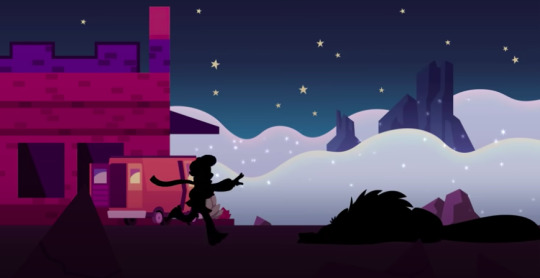
And we can also possibly hypothesise that the continued damage to the “heart” weakens Mystery or weakens his will -- we see after Vivi’s injury that Mystery has a total of 7 out of 8 ruptures and this is when we see the beginnings of the possession:


Could his will be wavering as his strength diminishes? And why does the injury of people close to him give him power despite it having a harmful effect on him and draining his strength?
This newest instalment of Mystery Skulls Animated gave us such a goldmine of new information and I absolutely cannot WAIT to see how it all links up in the end!!!!
Thank you so much, @mysterybensmysteryblog, @artsyfeathersartsyblog, @heilos, @squigglydigg and @amtrax!!!!
#mystery skulls#mystery skulls animated#msa#mystery skulls future#mystery skulls the future#mystery skulls animated the future#mystery skulls animated future#mystery skulls mystery#mystery skulls animated mystery#murder mystery#mystery skulls murder mystery#mystery skulls animated murder mystery#mystery skulls theory#mystery skulls theories#mystery skulls animated theory#mystery skulls animated theories
404 notes
·
View notes
Note
hi so you reblogged this a few days ago but i'm really curious, how did you interpret the ship vs speech thing in the beast island episode???
in reference to this
absolutely no offense meant to the OP of that post. i loved that meta! i was just literally surprised when i read the last paragraph because i had interpreted it totally differently without really thinking more about it…and this ask has given me an excuse to think about it way too much. (no, seriously, what happened here oh my god i’m so sorry IT STARTED OUT WITH A PARAGRAPH IT WAS ONLY A PARAGRAPH-- ahem.)

when entrapta said it was the ship, not bow’s speech about friendship, that jammed the signal, i assumed she was trying to deflect. however, in hindsight, i realized that it was entirely possible that she was being sincere. she’s not the type to lie, after all, and she still admitted that she appreciated his gesture.
but…rewatching the whole scene, i noticed an interesting detail.

this is entrapta before bow’s speech. dull gray eyes, no pupils.

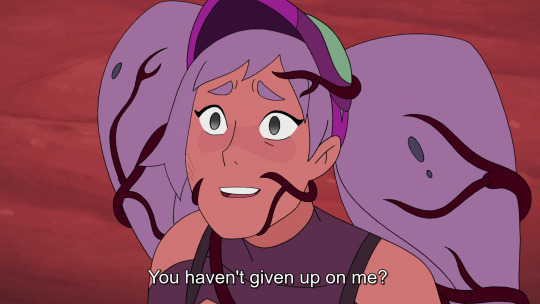
this is entrapta during bow’s speech. a flash of pupils, then dull gray eyes again.
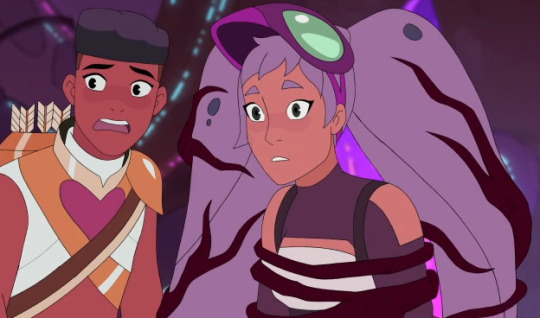
this is entrapta after bow’s speech (i cropped the screencap so that you could see the pupils more easily). steady pupils, and more consistent dark gray, rather than a muted gradient.
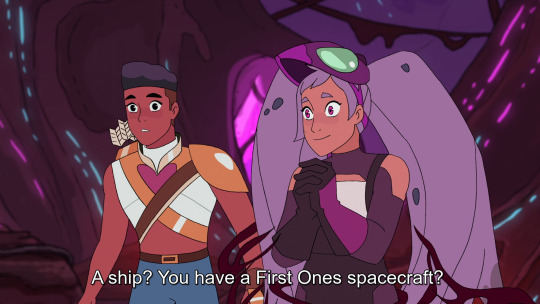
this is entrapta after adora mentions the ship. steady pupils with restored color.
excluding the possibility of a simple animator error (which is…very possible, i’ll admit), this would imply that bow was getting through to entrapta, and would have done so, if it weren’t for adora’s clever interruption that reminded entrapta of something that was immediately exciting and wasn’t so confusing (read: horrifically painful).

i really hope it wasn’t an animator error, because it attaches even more significance to entrapta’s eyes being the window into her soul, which she hides whenever she’s upset–including earlier in that same episode when they mentioned hordak. a lot of autistic people struggle to hide their emotions or lie, which might explain why entrapta goes to such lengths to physically block that window to her soul when she’s upset.
so, why would entrapta lie?



…unless she didn’t think she was lying. unless she was lying to herself, which is another thing that she did earlier in that episode. yeah, she was totally okay, which was why she hid her face when hordak was mentioned and actually shut down (stopped talking and moving) when bow mentioned that other people were waiting for her.
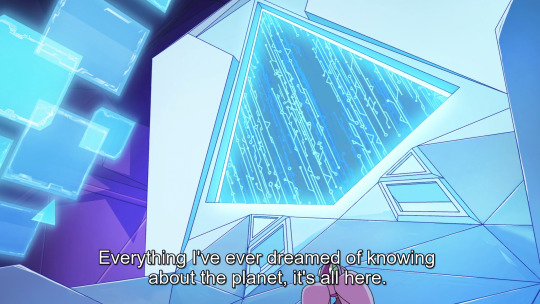
but hey, why would she not be okay? she had access to everything she’d ever dreamed about! first ones tech! limitless information! so exciting!
if it was her excitement about first ones tech that really jammed the signal, then why wouldn’t she have been immune to it even after thinking about her failed friendships? as she mentioned earlier, this island was a goldmine for first ones tech. other people warning her that it was falling apart wouldn’t have deterred her. she could have escaped that particular area and tried to explore another part of the island. if that wasn’t enough, adora was offering her an opportunity to interact directly with the heart of etheria. why wouldn’t that have rendered her immune to any of the signal’s effects? how did the signal get to her at all if first ones tech itself was enough to jam it?

she was going to let herself die in complete despair, just like the dead beasts that made up the backdrop of the island, surrounded by that tech that was supposedly what actually saved her, while smiling and telling her friends that she belonged there. it was never going to make her loneliness go away. it was never going to make her truly happy. it was never going to replace friendship.
thus, i think entrapta spoke her truth, but it wasn’t the truth. the truth was that she was hurting and thought that tech alone could make the hurt go away. yet, even then, i think she knew on some level what the truth was, which was why she stuttered and blushed when she said she was glad that bow was her friend; it was uncomfortably close to what actually happened.
alternatively, i could be overthinking it big time, but either way, this was super fun to think about and type out, so thank you for asking!
148 notes
·
View notes
Link
It’s wild what sort of stuff can pop up on the web with little to no recognition whatsoever. The following Livejournal I found is a recounting by Sergey Bessmertny, a person who worked as a technician on the set of Andrei Tarkovsky’s Stalker. It features a goldmine of previously unseen materials related to the film’s history and production, it’s absolutely worth a look for all the insights and behind the scenes stills provided by the author along with the screencaps of the now lost 1977 version of Stalker (the first of three different versions that Tarkovsky directed). I still have yet to read it all the way through, I found it just a little earlier today.
0 notes
Text
it’s weird how tumblr just Doesn’t talk about community??????? like most popular sitcoms half at least a couple dozen sets of popular screencaps/reaction gifs/etc going around but the only things i ever see for community are the infamous troy walking in with the pizzas scene, “i can excuse racism but i draw the line at animal cruelty” “you can excuse racism?”, & "if i was ever turned into a donut--” “you’d eat yourself” “i wouldn’t even question it” and that’s IT like. this show is such a goldmine it is THE sitcom that defines sitcoms and it’s so fucking meta and it’s. god this isn’t a coherent post but i love community and i’m so constantly puzzled by the fact that i see so little of it
32 notes
·
View notes
Note
Hey, this is really random, but I'm making a Cas video for the Creation music video contest. Can you by chance think of any scenes from the show where Cas is a) totally badass, b) kinda calm or just like sitting and thinking or something like that, and/or c) hurt or injured? There's just so many hours of Cas episodes and I don't have time to watch every single one. Thanks!
Hiya!! Good luck with the video contest!! here’s some links to screencaps/gifs :D
Bamf!cas
this scene from 6x20
this scene from 6x20 (2)
this scene from 4x01
this scene from 10x10
this scene from 4x16
this scene from 5x18
this scene from 5x18 (2)
this scene from 9x14
this scene from 12x10
this scene from 11x06
Calm scenes of cas
both of these scenes from 8x17
also this scene from 8x17
this scene from 12x12
this scene from 12x10
this scene from 6x18
Hurt!cas
this scene from 10x22
this scene from 8x21
all of these scenes from 9x09
this scene from 11x03
this scene from 11x01
12x10 and 12x12 are a goldmine for cas scenes
21 notes
·
View notes
Photo

Look at these smug assholes.
#their fucking faces#this scene is a screencap goldmine#Boardwalk Empire#Arnold Rothstein#Lucky Luciano#Charlie Luciano#mine#otp: you can be the boss daddy you can be the boss
50 notes
·
View notes